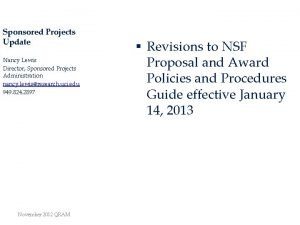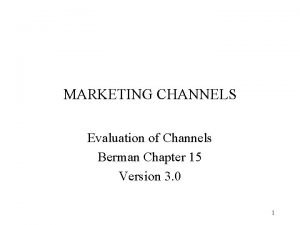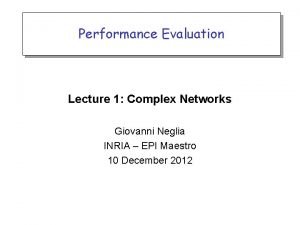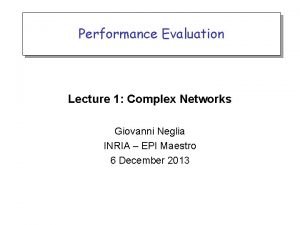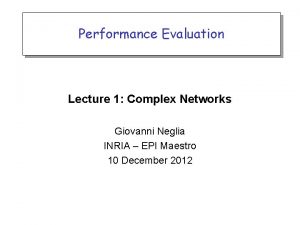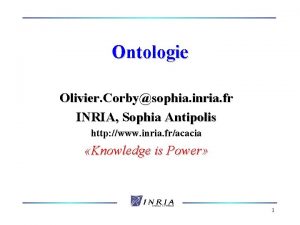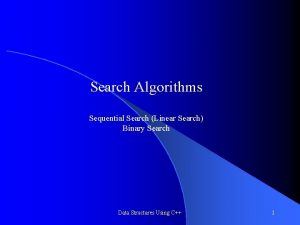Performance Evaluation Sponsored Search Markets Giovanni Neglia INRIA


















































- Slides: 50

Performance Evaluation Sponsored Search Markets Giovanni Neglia INRIA – EPI Maestro 4 February 2013

Google r A class of games for which there is a function P(s 1, s 2, …s. N) such that m For each i Ui(s 1, s 2, …xi, …s. N)>Ui(s 1, s 2, …yi, …s. N) if and only if P(s 1, s 2, …xi, …s. N)>P(s 1, s 2, …yi, …s. N) r Properties of potential games: Existence of a pure-strategy NE and convergence to it of best -response dynamics r The routing games we considered are particular potential games

How it works r Companies bid for keywords r On the basis of the bids Google puts their link on a given position (first ads get more clicks) r Companies are charged a given cost for each click (the cost depends on all the bids)

Some numbers r ≈ 95% of Google revenues (46 billions$) from ads investor. google. com/financial/tables. html m 87% of Google-Motorola revenues (50 billions$) m r Costs m "calligraphy pens" $1. 70 m "Loan consolidation" $50 m "mesothelioma" $50 per click r Click fraud problem

Outline r Preliminaries m Auctions m Matching markets r Possible approaches to ads pricing r Google mechanism r References m Easley, Kleinberg, "Networks, Crowds and Markets", ch. 9, 10, 15

Types of auctions r 1 st price & descending bids r 2 nd price & ascending bids

Game Theoretic Model r N players (the bidders) r Strategies/actions: bi is player i’s bid r For player i the good has value vi r pi is player i’s payment if he gets the good r Utility: m vi-pi if player i gets the good m 0 otherwise r Assumption here: values vi are independent and private m i. e. very particular goods for which there is not a reference price

Game Theoretic Model r N players (the bidders) r Strategies: bi is player i’s bid r Utility: m vi-bi if player i gets the good m 0 otherwise r Difficulties: m Utilities of other players are unknown! m Better to model the strategy space as continuous m Most of the approaches we studied do not work!

2 nd price auction r Player with the highest bid gets the good and pays a price equal to the 2 nd highest bid r There is a dominant strategies I. e. a strategy that is more convenient independently from what the other players do m Be truthful, i. e. bid how much you evaluate the good (bi=vi) m Social optimality: the bidder who value the good the most gets it! m

bi=vi is the highest bids bi’>bi bi bk bk Ui=vi-bk>vi-bi=0 Ui’=vi-bk bh bh bn bn Bidding more than vi is not convenient

bi=vi is the highest bids bi bk bk bi’<bi Ui=vi-bk>vi-bi=0 bh bh bn bn Ui’=0 Bidding less than vi is not convenient (may be unconvenient)

bi=vi is not the highest bids bi’>bi bk Ui’=vi-bk<vi-bi=0 bk bi Ui=0 bh bh bn bn Bidding more than vi is not convenient (may be unconvenient)

bi=vi is not the highest bids bk bk bi bi’<bi Ui=0 bh bh bn bn Ui’=0 Bidding more than vi is not convenient

Seller revenue r N bidders r Values are independent random values between 0 and 1 r Expected ith largest utility is (N+1 -i)/(N+1) r Expected seller revenue is (N-1)/(N+1)

1 st price auction r Player with the highest bid gets the good and pays a price equal to her/his bid r Being truthful is not a dominant strategy anymore! r How to study it?

1 st price auction r Assumption: for each player the other values are i. i. d. random variables between 0 and 1 m to overcome the fact that utilities are unknown r Player i’s strategy is a function s() mapping value vi to a bid bi s() strictly increasing, differentiable function m 0≤s(v)≤v s(0)=0 m r We investigate if there is a strategy s() common to all the players that leads to a Nash equilibrium

1 st price auction r Assumption: for each player the other values are i. i. d. random variables between 0 and 1 r Player i’s strategy is a function s() mapping value vi to a bid bi r Expected payoff of player i if all the players plays s(): m Ui(s, …s) = vi. N-1 (vi-s(vi)) prob. i wins i’s payoff if he/she wins

1 st price auction r Expected payoff of player i if all the players play s(): m Ui(s, …s) = vi. N-1 (vi-s(vi)) r What if i plays a different strategy t()? m If all players playing s() is a NE, then : m Ui(s, …s) = vi. N-1 (vi-s(vi)) ≥ vi. N-1 (vi-t(vi)) = = Ui(s, …t, …s) r Difficult to check for all the possible functions t() different from s() r Help from the revelation principle

The Revelation Principle vi s() bi vi t() b i' v i' s() b i' r All the strategies are equivalent to bidder i supplying to s() a different value of vi

1 st price auction r Expected payoff of player i if all the players plays s(): m Ui(v 1, …vi, …v. N) = Ui(s, …s) = vi. N-1 (vi-s(vi)) r What if i plays a different strategy t()? r By the revelation principle: m Ui(s, …t, …s) = Ui(v 1, …v. N) = v. N-1 (vi-s(v)) r If vi. N-1 (vi-s(vi)) ≥ v. N-1 (vi-s(v)) for each v (and for each vi) m Then all players playing s() is a NE

1 st price auction r If vi. N-1 (vi-s(vi)) ≥ v. N-1 (vi-s(v)) for each v (and for each vi) m Then all players playing s() is a NE r f(v)=vi. N-1 (vi-s(vi)) - v. N-1 (vi-s(v)) is minimized for v=vi r f’(v)=0 for v=vi, i. e. (N-1) vi. N-2 (vi-s(v)) + vi. N-1 s’(vi) = 0 for each vi m s’(vi) = (N-1)(1 – s(vi)/vi), s(0)=0 m Solution: s(vi)=(N-1)/N vi m

1 st price auction r All players bidding according to s(v) = (N-1)/N v is a NE r Remarks They are not truthful m The more they are, the higher they should bid m r Expected seller revenue m (N-1)/N E[vmax] = (N-1)/N N/(N+1) = (N-1)/(N+1) m Identical to 2 nd price auction! m A general revenue equivalence principle

Outline r Preliminaries m Auctions m Matching markets r Possible approaches to ads pricing r Google mechanism r References m Easley, Kleinberg, "Networks, Crowds and Markets", ch. 9, 10, 15

Matching Markets goods buyers 1 1 v 11, v 21, v 31 2 2 v 12, v 22, v 32 3 3 v 12, v 22, v 32 vij: value that buyer j gives to good i How to match a set of different goods to a set of buyers with different evaluations

Matching Markets p 1=2 1 1 12, 4, 2 p 2=1 2 2 8, 7, 6 p 3=0 3 3 7, 5, 2 Which goods buyers like most? Preferred seller graph How to match a set of different goods to a set of buyers with different evaluations

Matching Markets p 1=2 1 1 12, 4, 2 p 2=1 2 2 8, 7, 6 p 3=0 3 3 7, 5, 2 Which goods buyers like most? Preferred seller graph r Given the prices, look for a perfect matching on the preferred seller graph r There is no such matching for this graph

Matching Markets p 1=3 1 1 12, 4, 2 p 2=1 2 2 8, 7, 6 p 3=0 3 3 7, 5, 2 Which goods buyers like most? Preferred seller graph r But with different prices, there is

Matching Markets p 1=3 1 1 12, 4, 2 p 2=1 2 2 8, 7, 6 p 3=0 3 3 7, 5, 2 Which goods buyers like most? Preferred seller graph r But with different prices, there is r Such prices are market clearing prices

Market Clearing Prices r They always exist m And can be easily calculated if valuations are known r They are socially optimal in the sense that they maximize the sum of all the payoffs in the network (both sellers are buyers)

Outline r Preliminaries m Auctions m Matching markets r Possible approaches to ads pricing r Google mechanism r References m Easley, Kleinberg, "Networks, Crowds and Markets", ch. 9, 10, 15

Ads pricing Ads positions companies 1 r 1 1 2 r 2 2 v 2 3 r 3 3 v 3 ri: click rate for an ad in position i (assumed to be independent from the ad and known a priori) v 1 vi: value that company i gives to a click How to rank ads from different companies

Ads pricing as a matching market Ads positions companies 1 r 1 1 v 1 r 1, v 1 r 2, v 1 r 3 2 r 2 2 v 2 r 1, v 2 r 2, v 2 r 3 3 v 3 r 1, v 3 r 2, v 3 r 3 ri: click rate for an ad in position i (assumed to be independent from the ad and known a priori) vi: value that company i gives to a click r Problem: Valuations are not known! r … but we could look for something as 2 nd price auctions

The VCG mechanism r The correct way to generalize 2 nd price auctions to multiple goods r Vickrey-Clarke-Groves r Every buyers should pay a price equal to the social value loss for the others buyers m Example: consider a 2 nd price auction with v 1>v 2>…v. N • With 1 present the others buyers get 0 • Without 1, 2 would have got the good with a value v 2 • then the social value loss for the others is v 2

The VCG mechanism r The correct way to generalize 2 nd price auctions to multiple goods r Vickrey-Clarke-Groves r Every buyers should pay a price equal to the social value loss for the others buyers If VBS is the maximum total valuation over all the possible perfect matchings of the set of sellers S and the set of buyers B, m If buyer j gets good i, he/she should be charged VB-j. S - VB-j. S-i m

VCG example Ads positions companies 1 r 1=10 1 v 1=3 2 r 2=5 2 v 2=2 3 r 3=2 3 v 3=1 ri: click rate for an ad in position i (assumed to be independent from the ad and known a priori) vi: value that company i gives to a click

VCG example Ads positions companies 1 1 30, 15, 6 2 2 20, 10, 4 3 3 10, 5, 2

VCG example Ads positions companies 1 1 30, 15, 6 2 2 20, 10, 4 3 3 10, 5, 2 r This is the maximum weight matching r 1 gets 30, 2 gets 10 and 3 gets 2

VCG example Ads positions companies 1 1 30, 15, 6 2 2 20, 10, 4 3 3 10, 5, 2 r If 1 weren’t there, 2 and 3 would get 25 instead of 12, r Then 1 should pay 13

VCG example Ads positions companies 1 1 30, 15, 6 2 2 20, 10, 4 3 3 10, 5, 2 r If 2 weren’t there, 1 and 3 would get 35 instead of 32, r Then 2 should pay 3

VCG example Ads positions companies 1 1 30, 15, 6 2 2 20, 10, 4 3 3 10, 5, 2 r If 3 weren’t there, nothing would change for 1 and 2, r Then 3 should pay 0

The VCG mechanism r Every buyers should pay a price equal to the social value loss for the others buyers If VBS is the maximum total valuation over all the possible perfect matchings of the set of sellers S and the set of buyers B, m If buyer j gets good i, he/she should be charged VB-j. S - VB-j. S-i m r Under this price mechanism, truth-telling is a dominant strategy

Outline r Preliminaries m Auctions m Matching markets r Possible approaches to ads pricing r Google mechanism r References m Easley, Kleinberg, "Networks, Crowds and Markets", ch. 9, 10, 15

Google’s GSP auction r Generalized Second Price r Once all the bids are collected b 1>b 2>…b. N r Company i pays bi+1 r In the case of a single good (position), GSP is equivalent to a 2 nd price auction, and also to VCG r But why Google wanted to implement something different? ? ?

GSP properties r Truth-telling may not be an equilibrium

GSP example Ads positions companies 1 r 1=10 1 v 1=7 2 r 2=4 2 v 2=6 3 r 3=0 3 v 3=1 ri: click rate for an ad in position i (assumed to be independent from the ad and known a priori) vi: value that company i gives to a click r If each player bids its true evaluation, 1 gets a payoff equal to 10 r If 1 bids 5, 1 gets a payoff equal to 24

GSP properties r Truth-telling may not be an equilibrium r There is always at least 1 NE maximizing total advertiser valuation

GSP example Ads positions companies 1 r 1=10 1 v 1=7 2 r 2=4 2 v 2=6 3 r 3=0 3 v 3=1 ri: click rate for an ad in position i (assumed to be independent from the ad and known a priori) vi: value that company i gives to a click r Multiple NE m 1 bids 5, 2 bids 4 and 3 bids 2 m 1 bids 3, 2 bids 5 and 3 bids 1

GSP properties r Truth-telling may not be an equilibrium r There is always at least 1 NE maximizing total advertiser valuation r Revenues can be higher or lower than VCG Attention: the revenue equivalence principle does not hold for auctions with multiple goods! m Google was targeting higher revenues… m … not clear if they did the right choice. m

GSP example Ads positions companies 1 r 1=10 1 v 1=7 2 r 2=4 2 v 2=6 3 r 3=0 3 v 3=1 r Multiple NE m 1 bids 5, 2 bids 4, 3 bids 2 google’s revenue=48 m 1 bids 3, 2 bids 5, 3 bids 1 google’s revenue=34 r With VCG, google’s revenue=44

Other issues r Click rates are unknown and depend on the ad! Concrete risk: low-quality advertiser bidding high may reduce the search engine’s revenue m Google’s solution: introduce and ad-quality factor taking into account actual click rate, relevance of the page and its ranking m • Google is very secretive about how to calculate it => the market is more opaque r Complex queries, nobody paid for m Usually engines extrapolate from simpler bids
 Inria holidays dataset
Inria holidays dataset Sfa email
Sfa email Cordelia schmid
Cordelia schmid Cordelia schmid
Cordelia schmid Mutual fund flows and performance in rational markets
Mutual fund flows and performance in rational markets Tamu srs
Tamu srs Who sponsored house bill 393
Who sponsored house bill 393 Dbhds sponsored residential regulations
Dbhds sponsored residential regulations Usc sponsored projects accounting
Usc sponsored projects accounting Uci sponsored projects
Uci sponsored projects Usc sponsored projects accounting
Usc sponsored projects accounting Manufacturer sponsored retailer franchise system
Manufacturer sponsored retailer franchise system Government sponsored recreation
Government sponsored recreation Supply chain management and marketing channels
Supply chain management and marketing channels The agency sponsored by the united nations that compiles
The agency sponsored by the united nations that compiles Ndsu sponsored programs
Ndsu sponsored programs Uva sponsored account
Uva sponsored account Accelerated clinical trial agreement acta
Accelerated clinical trial agreement acta When was john cabot born
When was john cabot born Who sponsored vasco nunez de balboa
Who sponsored vasco nunez de balboa Information search and evaluation
Information search and evaluation Computer architecture performance evaluation methods
Computer architecture performance evaluation methods Portfolio performance evaluation problems
Portfolio performance evaluation problems Sales performance appraisal
Sales performance appraisal A channel member performance audit may be described as:
A channel member performance audit may be described as: Progress and performance measurement and evaluation
Progress and performance measurement and evaluation Computer system performance evaluation
Computer system performance evaluation Usmc comparative assessment
Usmc comparative assessment Measurement and evaluation in human performance 5e download
Measurement and evaluation in human performance 5e download Direct support professional performance evaluation
Direct support professional performance evaluation Performance evaluation for decentralized operations
Performance evaluation for decentralized operations Vertical jump adalah
Vertical jump adalah Purchasing performance evaluation
Purchasing performance evaluation Citibank performance evaluation
Citibank performance evaluation Housekeeping appraisal comments
Housekeeping appraisal comments Evaluation for unit 6
Evaluation for unit 6 Stronge leader effectiveness performance evaluation model
Stronge leader effectiveness performance evaluation model Progress and performance measurement and evaluation
Progress and performance measurement and evaluation Performance evaluation using variances from standard costs
Performance evaluation using variances from standard costs Library staff performance evaluation
Library staff performance evaluation Channel performance evaluation
Channel performance evaluation Performance evaluation model
Performance evaluation model Chra europe region employment
Chra europe region employment Pep performance evaluation
Pep performance evaluation Comparison of uninformed search strategies
Comparison of uninformed search strategies Federated search vs discovery
Federated search vs discovery èinterest
èinterest Federated search vs distributed search
Federated search vs distributed search Informed search and uninformed search
Informed search and uninformed search Images search yahoo
Images search yahoo Best first search
Best first search









